The NATI folders and editioned artworks
in the Gazprombank Collection
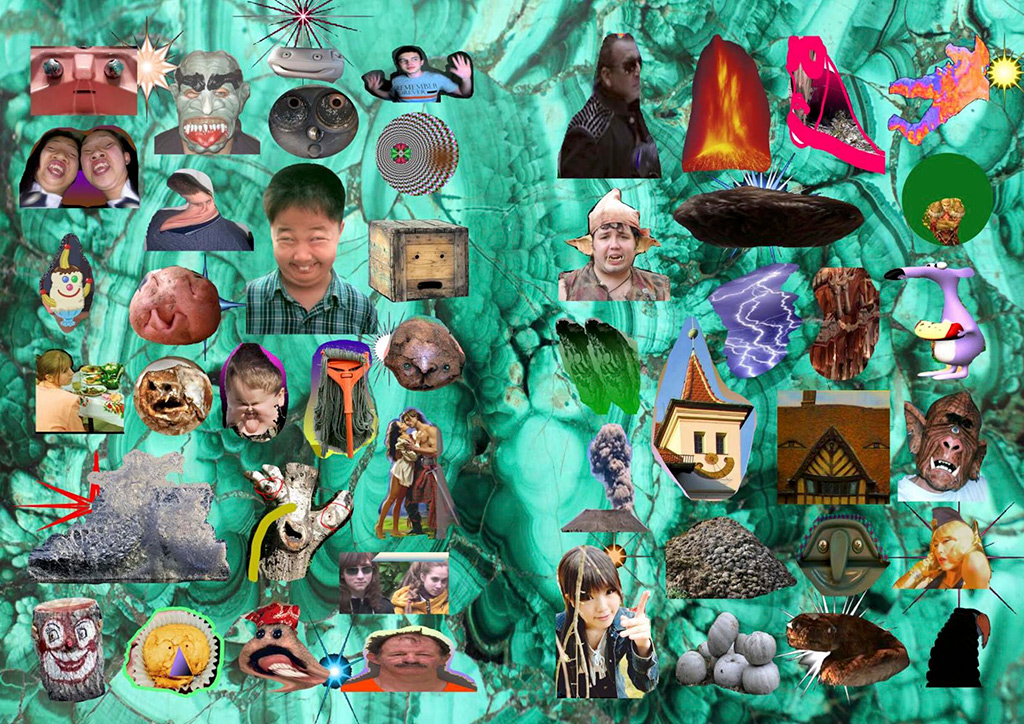
Ivan Gorshkov. «Twin Peaks 3». From the series «Twin Peaks». NATI I. 2018.
Editioned artworks, and particularly works on paper, have long been a significant segment of the art market and a target for collectors. Whereas ten years ago the initiative by Phillips auction house to hold a sale titled Editions appeared innovative, now many auction houses run such sales. Something else has changed too: where previously editioned artworks were proposed mainly to young buyers just starting their collections and aiming to do so with minimal outlay, now such works are also purchased by major collectors. They are particularly interested in works which have something unique about them, like the limited edition NATI Folders, published by the art platform Shaltai Editions.
Each NATI folder is produced in an edition of 30. Both folders published to date (2018 and 2019) are in the Gazprombank Collection. Corporate Director of the collection Marina Sitnina commented, “As collectors we aim to acquire the widest possible range of genres and techniques within Russian contemporary art. We keep an eye on all the news and trends in the field, including those developments in the market which reflect artistic developments. This is all within my field of vision”.
NATI (New Archive of Limited Edition Art) was inspired by the history of Moscow conceptualism. In 1981, Andrei Monastyrsky and Lev Rubinstein had the idea to collect into folders the works and texts of the Moscow conceptualists, artists and writers who were close to their circle. Each participant was given envelopes in which to place the works they wished to present (drawings, photographs, texts) and that is how the Moscow Archive of New Art (MANI) was born. Three artists who took place in the original project in the 1980s are also part of NATI: Andrei Monastyrsky, the inspiration and driving force behind the creation of the MANI folders, Igor Makarevich and Elena Elagina. They were joined by Irina Korina, Victor Alimpiev, and Ivan Gorshkov. Kirill Glushchenko created the design and structure of the folder. NATI proposed that the artists produce original works in a limited edition using any technique they chose. Making limited edition works was often an experiment for the artists themselves.
Collector Valeria Rodnyanskaya, who founded the platform Shaltai Editions, said, “Today, against the background of ubiquitous digitization, all forms of manual printing look like real, handmade work. Now more than ever, the artist is present within limited edition artworks, the so-called artist’s aura. For me, the fragile nature of paper and the charm of handmade techniques are particularly attractive.
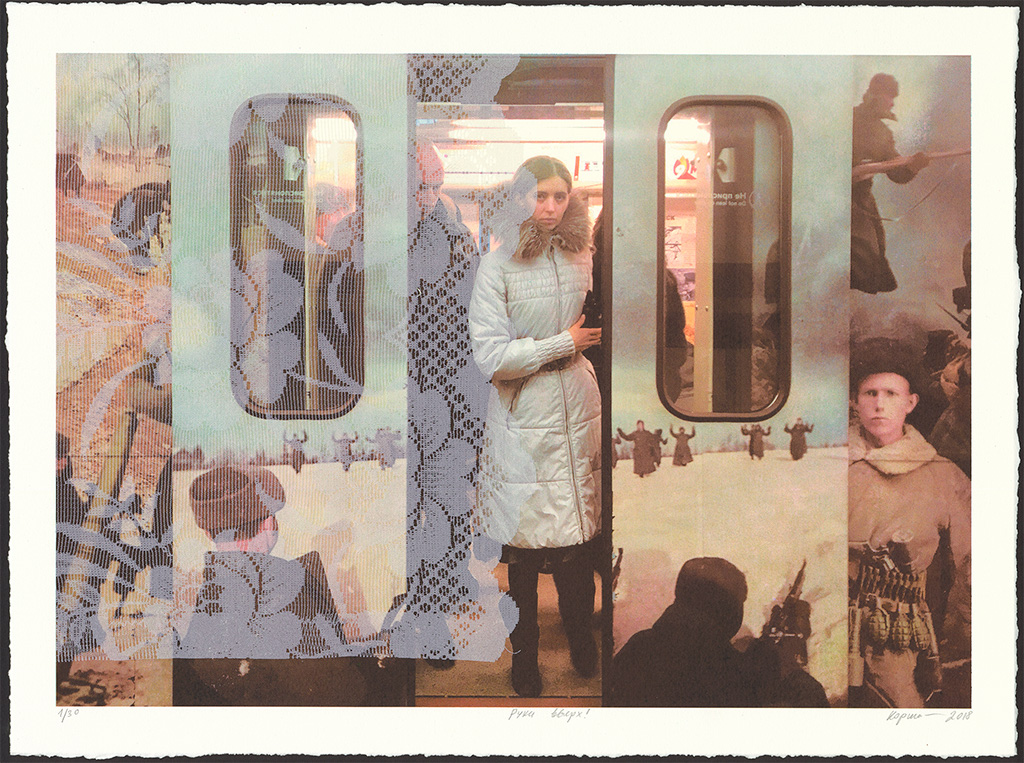
Irina Korina. «Hands up!». From the series «Everything will come true». NATI I. 2018.
From September to November 2019, the NATI archive was exhibited at the New Tretyakov as part of the exhibition A Very Important Message. NATI is a homage to the Moscow Archive of New Art. That’s where the idea came from to work with Andrei Monastrsky, Igor Makarevich, Elena Elagina, Vadim Zakharov, Yuri Albert, and Irina Nakhova. All of these important artists were very positive about the idea of taking part in the New Archive of Limited Edition Art. For the Moscow conceptualists of the early 1980s, MANI offered not only a survival strategy but also the possibility of a portable, travelling exhibition. The NATI archive has the same potential, thanks to which it is easy to create an exhibition around it, with the participation of a unique group of artists.”
Perspicacious publishers and collectors have been commissioning editioned works (and book illustrations) from major artists since the beginning of the twentieth century. That is how the genre livre d’artiste came into being (the term was coined by Ambroise Vollard, gallerist to the postimpressionists, for books with illustrations by famous artists). Now they cost tens of thousands of euros and are something to collect. Postwar publishers had the same experience: over a period of fifty years, gallerist and designer Jörg Schellmann commissioned editioned works from some of the world’s most important artists. Recently, works from his collection were auctioned by Phillips and sold for 100 times the amount they cost when the edition was first created.
The first NATI folder, published in 2018, was up for auction at Phillips last autumn. It included 22 works by 6 artists and sold for £6,875 (around 566,000 roubles), against an estimate of £5,000–£8,000. The market success of the folder was confirmed. Another confirmation of the artistic quality of this initiative was the exhibition which announced the publication of the second folder: in autumn 2019, the curator of the exhibition, Irina Gorlova, brought together the works from the second folder and paintings, drawings, and installations from the collection of the Tretyakov Gallery.
A number of the artists who have taken part in NATI told us about their projects and their attitude to editioned artworks as a genre or medium.
Yuri Albert
My project is called Three self portrait images and consists of three screenprinted sheets. They really are portrayals: three portrayals of one of my old works from the 1990s. Back then I made a series of portraits of my friends and colleagues and a self-portrait, using children’s plastic mosaic made by the company Ministeck. They sold a base with holes and multicoloured elements on prongs, which you stuck into the base. You could send the company a photo of anyone and they would mail you a printout on which various crosses or squares denoted the colour of the mosaic elements. Then you had to carefully complete the puzzle-mosaic. The result was original, mosaic relief photorealism. Almost thirty years later, I have simply portrayed various stages of that process.
The first sheet shows the preparatory printouts with the lines I made while working to show which parts were already done.
The second sheet shows the areas occupied by different colours, without being split up into a mosaic.
For the third sheet I placed some soft paper on top of my self-portrait and, with thick pencil hatching during which the lead kept catching on the uneven surface of the base, I used frottage to show the relief and materiality of the mosaic. But the portrayal of my face turned out to be unrecognisable because the depressions between the mosaic elements do not coincide with the borders of the colours.
In editioned artworks, regardless of whether they are engravings or ready-mades or a series of identical performances, I like the idea of creating less pathos around uniqueness. It’s clear that if the artist can repeat something many times, then it’s probably accessible to the viewer. And that means that our art is not so unique, elevated and inaccessible to the ordinary person as we might think.
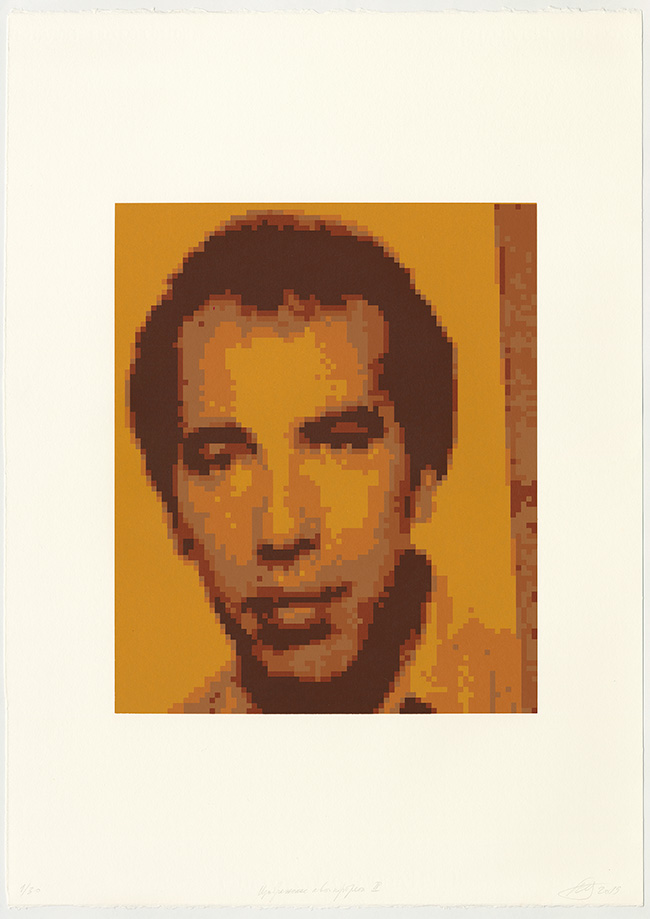
Yuri Albert. From the series «Three self portrait images». NATI II. 2019.
Andrei Monastyrsky
I was making collages around 2010 or 2011 and sometimes I make them now, although much less frequently. The main flow was then.
It’s like the “surrealisation” of ordinary situations with a rather comic form. The surrealism here is different, it isn’t serious. It’s comic, or somewhat funny, strange. In order that everything is very strange, that incomparable spaces can in some way become co-dependent, and that a new symbol appears, plus a transgression in the light of which everything looks and feels different and new contexts emerge. Maybe that’s how it actually is.
In fact, I don’t know what aesthetic effect they have. Of course, they are strange. It seems to me that they are more literary than anything else. In other words, looking at them as just sheets of graphic art is probably wrong because there you need to see particular narratives, like in old icons. And this is something different, they are narratives or stories that are strange, dream-like, surreal, funny, ironic, etc. But the work is more immersed in literature, in text. It is based on the fact that my interest in the first NATI folder was in texts and images and these collages are the same, text and image. Although the text can be closed, it can purely symbolic. In other words, the literary can be transmitted through images and not necessarily using words.
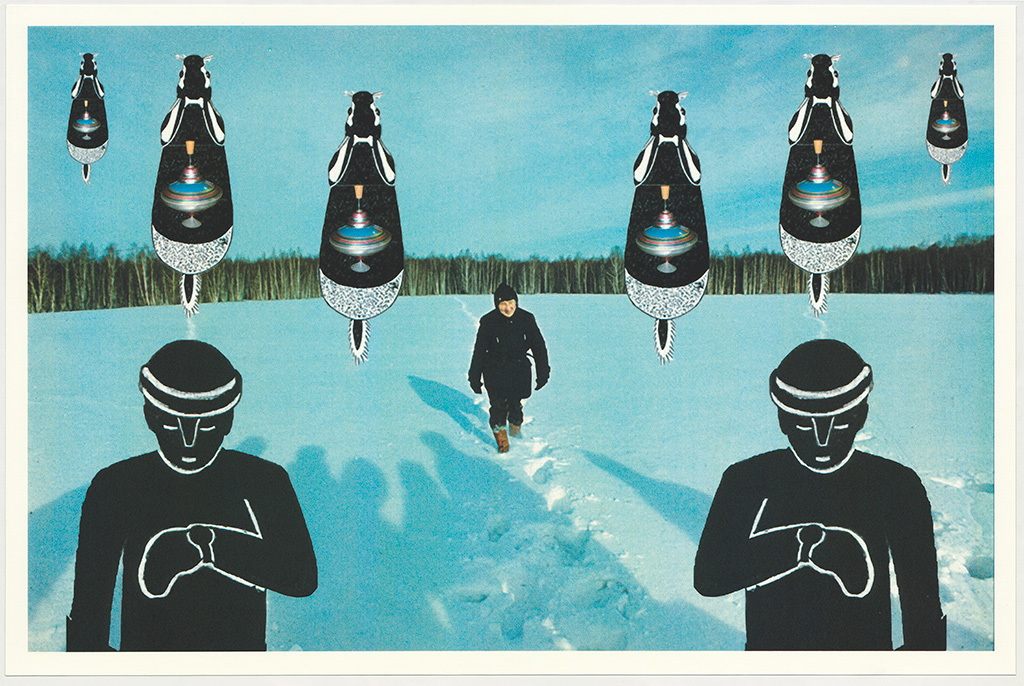
Andrey Monastyrsky. «Collage 4». From the «Collages». NATI II. 2019.
Olga Chernysheva
I wanted to make a print that would
1. Look like something that had been found, maybe in a second-hand bookshop or an archive, and would not give away the time it related to.
2. Incorporate movement and stillness.
3. Be a print from necessity. A print by origin. So that only the technique of printing could achieve the effect of a cloudy and semi-transparent window, behind which there is a silhouette and sky.
4. Allow me to understand something about printmaking and to work with professionals who are familiar with the language of print.
5. Be dedicated to Dziga Vertov, who populated the poster-like language of films with the melancholy and despair of the insane.
6. Flicker.
7. Fold like a butterfly.

Olga Chernysheva. «Dziga». NATI II. 2019.
Taus Makhacheva
In my Travel report No. 0172931 I traverse the axis of time from the past to the present and from the present to the future, documenting underwater depths, mountain heights and the space of the cosmos. This project is about real historical documents, in which facts are attended by myths, legends and stories and undergo transformations from epoch to epoch.
Combining flatness and relief (photo/screenprint and embossing), this series is dedicated to the heroism of the researchers of the secret and the unknown and to the desperate desire to believe the most absurd fabricated stories, which are invented when real discoveries prove impossible. Travel report is a homage to humankind’s centuries-old attempt to conquer time and space. For example, one of the images in the series is based on the Dagestani myth that the most simple and quick method to cross from one mountain to another is via a tightrope. Each work in the series is printed with images of patented devices which aim to overcome the impossible, such as an instrument that uses electrically charged particles in an electromagnetic field in order to literally manage time.
Travel report is a reminder of the fact that science fiction and real history often co-exist in harmony, without contradicting each other.
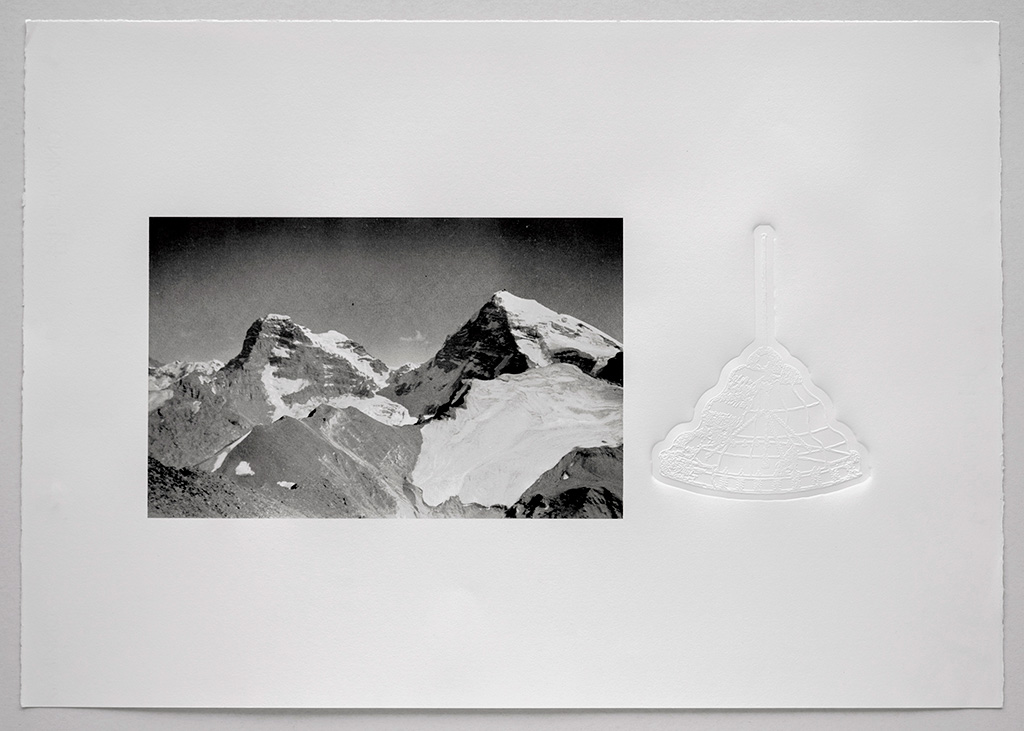
Taus Makhacheva. From series «Travel report №0172931». NATI II. 2019.
